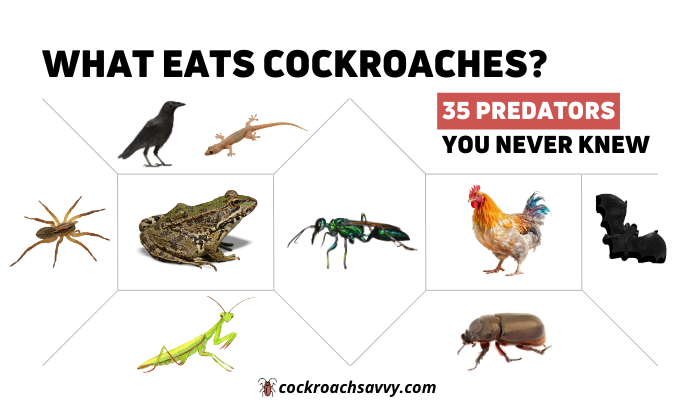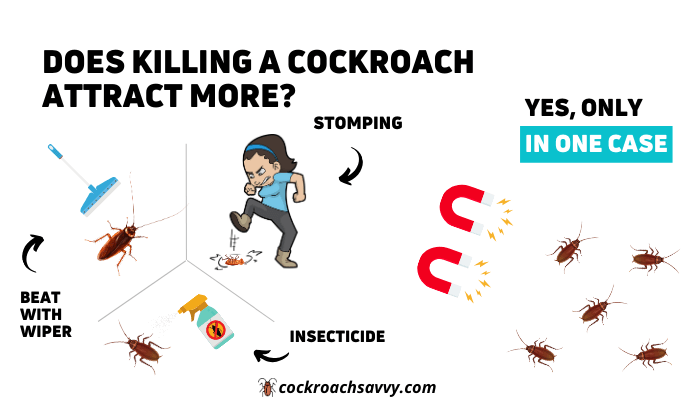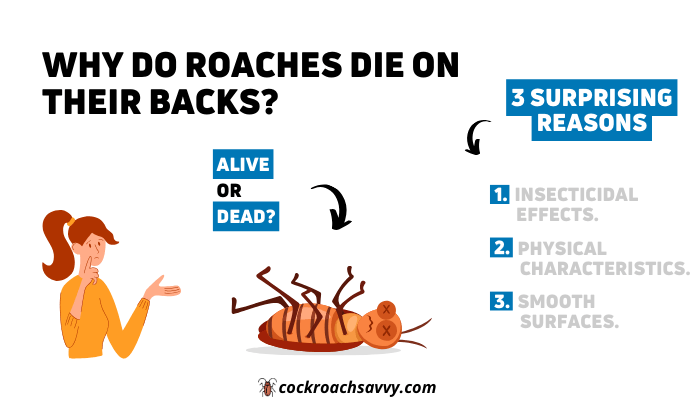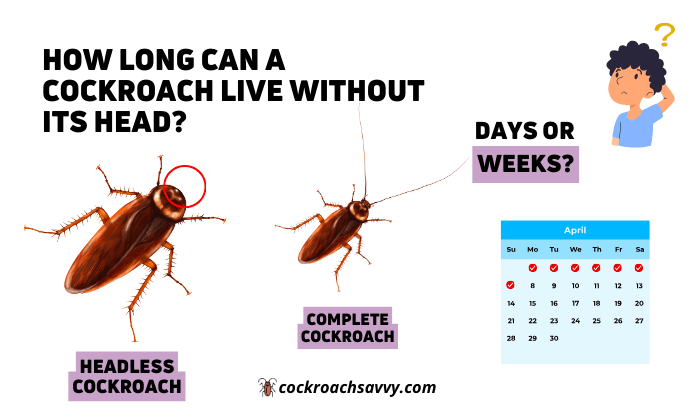Probably, you are tired of cockroaches in your home and are here to know what predators can help me in controlling my roach problem.
Well, there are lots of predators that prey on cockroaches,
BUT, Can They Help you in your cockroach infestation?
The clear answer is “NO”, Why?
Because the majority of predators from this list or any other cockroach predators list available on the internet are themselves considered pests. For example, who would want to keep crickets, ants, spiders, or chickens to eat cockroaches?
Besides these, there are some pets that eat cockroaches and can be kept at home. But they eat roaches in very small numbers. You can say it’s equivalent to nothing.
Then why should you read this if it does not help in your roach problem?
Well, these are the reasons why you should read this:
- There are some predators on this list that are of no concern to humans until disturbed. So it would be okay to let them be in your home.
- It’s interesting to know what will eat cockroaches and how they eat them.
- Every predator has a unique and interesting way of preying. For example, the Emerald Cockroach Wasp enslaves cockroaches by stinging their brains and injecting mind-controlling venom to control their behavior.
- While these animals, insects, and bugs, etc., aren’t necessarily practical to eliminate roaches inside your house, one thing they can be beneficial for is preventing roaches from starting a new infestation. Let’s say there were no cockroaches in your home, but somehow a cockroach that was looking to build nest or a pregnant roach gets to your house, and you have one of the roach predators. On its way, they both encounter each other. The predator will prey on that roach and save your house from starting a new roach infestation.
Here today, we will dig deep into the most detailed list of roach predators, from insects like emerald cockroach wasps to why cockroaches engage in cannibalism, to how and why humans eat cockroaches, to fungus that kills roaches slowly and gradually over a period of time, and the list goes on…
Let’s Start Preying on Roaches!
What Eats Cockroaches?
Cockroaches, the notorious survivors, are found on the menu of a diverse array of predators.
From insects to reptiles, mammals, and even some human cultures, the world of cockroach predators is both fascinating and complex.
Predators Highlight Reel
The below list shows all the predators explained in this article at a glance:
Insects:
Ants, wasps, crickets, and beetles are relentless predators of cockroaches, utilizing various strategies to catch them.
Arachnids:
Spiders, including tarantulas and huntsman spiders, have a taste for cockroach cuisine.
Reptiles:
Lizards like geckos, chameleons, iguanas, and monitor lizards are adept at hunting cockroaches.
Amphibians:
Frogs and toads, such as horned frogs and tree frogs, occasionally feast on cockroaches.
Mammals:
Mice, rats, hedgehogs, bats, and even larger animals like raccoons and opossums consider cockroaches a part of their diet.
Birds:
Chickens, ducks, pigeons, crows, and various other bird species relish cockroaches as a tasty treat.
Humans:
Some cultures incorporate cockroaches into their cuisine, and while not mainstream, they have nutritional value.
Fungi:
Beauveria bassiana and Metarhizium anisopliae are fungi used to control cockroach populations.
Roaches Aren’t An Easy Meal For Most Predators
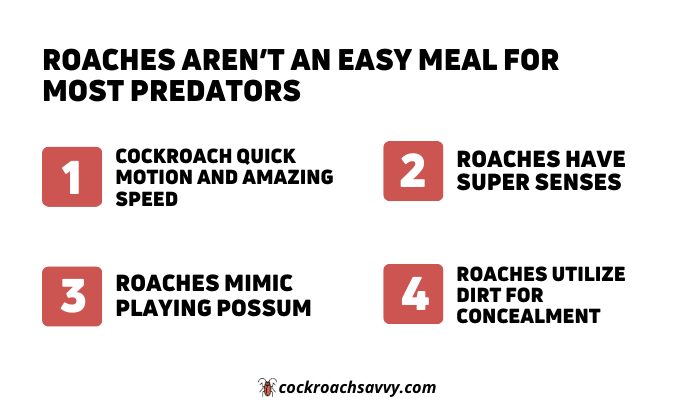
To every organism on this planet, their life is very important and they fight for their lives till the last with different defensive strategies.
Cockroaches too, use some defensive mechanisms that they use to save themself from being eaten/killed.
Cockroaches defensive mechanisms are not many and they are not something that can protect roaches from every predator. But they help them escape from some predators.
Let’s have a look at what they are;
1. Cockroach Quick Motion and Amazing Speed
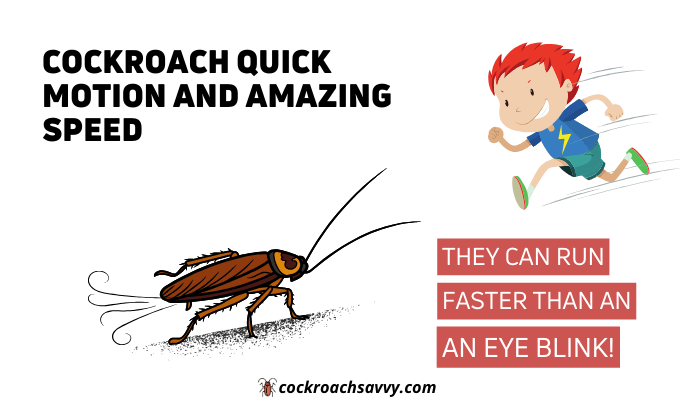
The main defensive mechanism of cockroaches is their quick motion and their incredible speed.
Except for some species, almost all cockroaches have the ability to run fast.
For example when ants decide to prey on a cockroach, and as the cockroach runs if that area is not confined, ants can’t chase him, and he will win.
Cockroach speed is indeed a formidable defense mechanism, making them elusive targets even for the most determined predators.
In cockroaches, the American cockroach is the fastest species and can boast a top speed of 2.9 – 3 mph. To give you a better idea, that rate of speed is what humans typically maintain while walking.
If that doesn’t wow you, here’s something incredible: If we could run as fast as roaches do compared to our size, we could reach speeds of up to 100 miles per hour, and wouldn’t need cars.
2. Roaches have Super Senses
Probably you would be thinking roaches are telepathic, because how can they know of impending danger.
Well, they are not telepathic but they have extraordinary sensory organs that allow them to navigate their environment, even in the darkness.
With Microscopic hairs on their body and super-sensitive antennae, roaches can detect the slightest movement of air.
Their heightened senses allow them to anticipate changes in air pressure, enabling them to elude danger by reacting faster than a potential predator can strike.
Most of the time, when you try to kill a cockroach by stomping and when you lift your foot to see the crushed cockroaches, you are surprised. Because the roaches reacted faster than you stomping on him.
3. Roaches Mimic Playing Possum
Not to be outdone by the animal kingdom’s performers, roaches have their version of “playing possum.”
Some species adopt the tactic of feigning death when threatened.
Much like possums that roll onto their backs to escape larger predators, roaches can strategically “play dead” to evade danger.
This deceptive maneuver buys them time, allowing them to emerge unscathed when predators lose interest.
4. Roaches Utilize Dirt for Concealment
Roaches are also masters of camouflage. They possess an innate ability to seek out hiding spots that match their color and texture, often burrowing into dirt or seeking refuge in crevices.
This subterranean refuge serves as a clever hideout, protecting them from predators that lack the means to unearth them.
For predators unskilled in the art of scent-based tracking, roaches’ underground abode becomes an impenetrable fortress
This natural concealment makes them inconspicuous to predators and helps them evade detection.
These are some of the main defensive tactics, that cockroaches employ to protect themself.
Aside from the above tactics, there are also some other defensive mechanisms like, Many species of Cockroaches can Jump and Fly too including German cockroaches (the kind found infesting most homes)
Although cockroaches tend to mostly rely on locomotion, they leap and fly when they are truly threatened.
Then some species can employ a chemical defence, when a predator comes near them they release a stink to scare off their predator. By doing so, when a big predator smells that stink, he thinks twice before eating such an awful smelly thing.
Here, we move to the main topic, for which you are here,
Natural Predators of Cockroaches
Certainly, there are lots of cockroach’s natural predator and every predator have its own way of attacking, catching, and killing cockroaches
With cockroaches having a long list of predators, we will cover as many as possible.
Almost all the people having cockroach infestation, actively look for some ways to get rid of them because I know how hectic it is having cockroaches all over the home.
While reading this, it will motivate you to use natural predators as pest control, but this needs to be done with caution. Because every predator on this list isn’t safe to be kept at home. And almost all of the predators listed here can’t help you sweep out an entire infestation.
Let’s first start with the predators, which are almost the size of roaches.
Insects That Eat Cockroaches
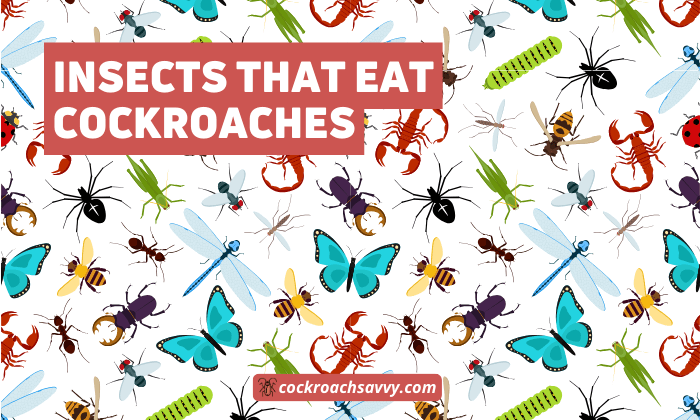
As cockroaches themselves are insects, they live in similar places to other insects and are often found building nests in the same places. So they mostly encounter each other.
Here it’s Insects vs insects (Cockroaches).
Ants – Do Ants Eat Cockroaches?
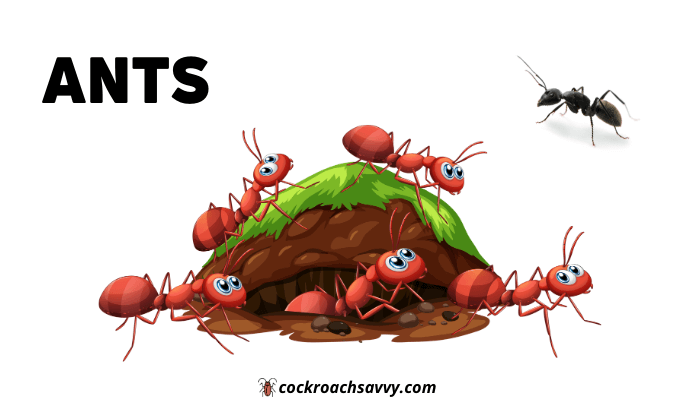
Yes, some species of ants can eat cockroaches.
For ants, cockroach is indeed something they would love to eat. But killing the cockroach is hard for ants;
Because a cockroach can simply run through a line of ants and ants can’t do anything, as cockroaches run much faster than ants.
The only case in which ants can easily kill a cockroach is when the space is confined, and the cockroach can’t escape that closed area or the roach is trapped in something.
Both fire ants and Argentine ants can kill a cockroach and eat it, but both species have different scenarios;
Argentine ants are too small to overpower a single cockroach on their own. But when they have the power of the entire colony with them, they can easily make the roach out of action.
On the other hand, fire ants don’t need the power of their whole colony to decimate a single roach because they are much faster and a little stronger. They can make the cockroach past tense with just a few of them.
The above two scenarios are not the times when ants feel happy. They feel joyful when they find a dead or semi-dead cockroach because now they do not have to do the struggle of first killing the cockroach.
If I have ants in my house, should I leave them to eat cockroaches?
You should NEVER. And nor I would do.
Because I think one cockroach is enough for 500 ants to feed on.
And you tell which one is better 1 cockroach or 500 ants?
Obviously, 1 cockroach. Because 1 cockroach is easier to handle rather than 500 ants.
And also leaving a pest in your home, to help you get rid of another pest is not a great idea.
Emerald Cockroach Wasp also known as Jewel wasp (ampulex compressa):
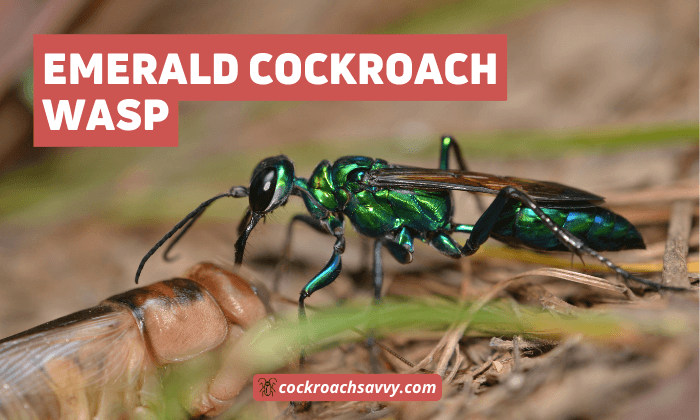
The predator whose way of preying, I love the most.
The Emerald Cockroach Wasp indeed kills and eats some cockroaches, but they won’t clear out an entire infestation for you.
Seeing this wasp in your house is a sign that there are probably some roaches in your house for sure.
Because the female of this wasp searches for Adult American roaches to lay her egg.
This whole process is the reason why the emerald cockroach wasp is on this list;
First of all, when the emerald cockroach wasp sees a cockroach, she approaches the roach and grabs the base of the roach’s wing. Then extends the point of her abdomen for the first sting into the first thoracic ganglion to temporarily paralyze her first pair of legs.
The venom in this first sting shuts down the ganglion motor circuitry to prevent leg movement. She does this to easily sting the second sting in the roach’s brain.
Now after the first pair of legs is paralyzed, she then inserts her long stinger into the cockroach’s brain through the neck to deliver the cocktail of mind-altering venom.
This venom injected into the brain takes a couple of minutes and has two effects;
- For the first half hour, it causes the brain to obsessively groom itself.
- Second, after half an hour, the brain becomes sluggish and does not try to escape.
In the meantime, the wasp searches for a suitable nest.
After finding a suitable place for the nest, she returns to the roach and gnaws off one of the roach’s antennae and takes a few refreshing sips of oozing juices.
And then walks her zombie cockroach to the burrow, like an obedient dog on a leash.
After walking the zombie to the burrow, she attaches an egg to the coxal segment of the middle leg.
Lastly, she searches for material and plugs the burrow’s entrance to keep the egg and her baby’s future food secure from scavengers.
Now, the wasp leaves and left her egg and the roach alone.
After two days the egg hatches into a larva that starts feeding on the roach’s leg juices.
Two molts later, the larva starts to work to make its way inside the live roach.
Inside the live cockroach body, the larva spends 40 days surviving on the roach’s internal organs and nutrition.
After 40 days, an adult wasp emerges from the cockroach carcass.
Look, how interesting and intriguing this entire process was!
Cockroaches – Do cockroaches eat other cockroaches?
Cockroaches are not picky at all and eat everything that constitutes food, even other cockroaches.
The first instinct of cockroaches is not to feed on other roaches; they only engage in cannibalism when there is a scarcity of food or they don’t have or see any other way of finding food.
Just like any other organism, whose primary motivation is their species’ survival and preservation, cockroaches do the same. Roaches always prefer eating dead roaches, not live ones. If things are dire, they may end up eating their own poop.
There is also a natural phenomenon in the cockroach’s body. When a roach dies, it releases a pheromone that acts as a warning and a food signal as a by-product.
Basically, it indicates to other roaches, “Do not come here; here is danger (what killed me might kill you),” and as a by-product, it signals other roaches that they can come and feed on the carcass of a dead roach.
However, this is only if there are no other food resources available. It means roaches should take the risk of coming to this carcass and feed on it, rather than dying from hunger.
In some cases, larger cockroaches do eat their eggs, nymphs (young), and smaller adult cockroaches. While cockroaches of all ages may eat dead cockroaches and shed skins.
Praying Mantis – Do Praying Mantis Eat Cockroaches?
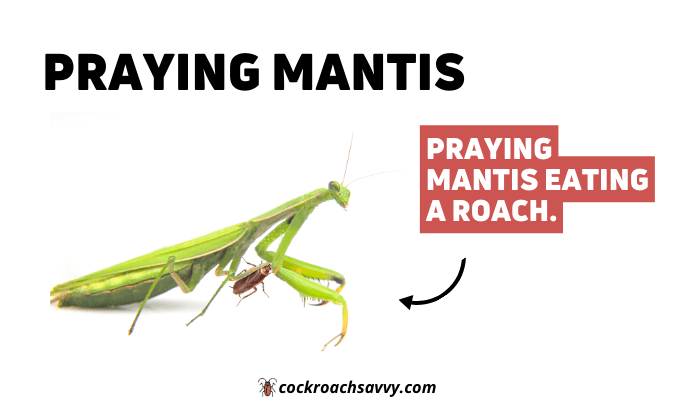
The praying mantis is equipped with a lot of natural abilities that make it easy for them to catch their prey.
First and the most noticeable weapon that they have is their long, grasping claws, with the help of which they pierce and hold the squirmiest prey.
Another natural virtual ability they have is swift reflexes, which enable the praying mantis to snatch up the quickest insects before they get a chance to flee.
Praying mantises can blend into their environment and wait patiently for their prey to come into range.
As soon as the prey is in range, the mantis ambushes it and grasps the prey with its long front legs, which takes a few milliseconds. Once fully grasped, the prey can’t then escape.
Praying mantises usually prefer to prey on small breeds of cockroaches, but they are also experts in ambushing all sizes of roaches.
Crickets – Do Crickets Eat Roaches
Yes, crickets can eat cockroaches, but they don’t.
As crickets are omnivores, they mostly tend to live in grassy areas, where roaches don’t go easily. So usually, they don’t encounter each other.
Since crickets can eat a variety of things, they always prefer to feed on trees, nectar, seeds, small insects and their larvae, etc.
Therefore it is very uncommon to see a cricket eating a cockroach.
Beetles – Occasionally Predators, Only Some Species:

Beetles do eat cockroaches, but not always, only occasionally.
According to the Smithsonian, beetles have over 350,000 described species, and more are constantly identified by taxonomists.
Being in such high numbers, it’s reasonable to find a few beetles that feed on roaches. There are beetles that feed on plants, decaying wood, dead animals, and even beetles that feed on feces; known as dung beetles.
The beetles that are predators include ground beetles, rove beetles, and soldier beetles. For sure, there are too many to list, but these are the ones I know.
Most beetles don’t have any special tactics for catching roaches or other insects. They just use their brute force to overtake and eat them.
On the roach side, unless it possesses the ability to escape by running, jumping, or flying, it is likely to become prey.
Certainly, there are many more insects that kill and eat cockroaches. Covering all of them would make this article boring and super lengthy.
So, let’s move to the second category of the list;
Animals That Eat Cockroaches
Here, comes the second category of this article. Below are all the animals that eat cockroaches, some of these, I have seen myself eating cockroaches and some I found while doing research for this article:
Lizards – Do Lizards Eat Cockroaches

In the wild, lizards are common predators of cockroaches.
Cockroaches, being full of nutrition, play an important role in the diet of many lizards.
As most species of lizards don’t have teeth, they instead utilize their digestive process to crush their prey (cockroach hard exoskeleton) and turn it into nutrition.
Another power of cockroaches, swift movement, also isn’t an issue for lizards because of the fast-moving tongue they have.
Some lizard species can’t consume large cockroaches like adult American cockroaches. They have a rule that they only eat bugs that are the size of the length between their eyes.
A common house gecko can eat up to 20 small roaches like German, Dubia, or young American cockroaches per serving.
Lizards, with their diverse species and dietary preferences, are no strangers to feasting on cockroaches.
Mainly, lizards that feast on roaches are Monitor lizards, Bearded dragons, Chameleons, Geckos, and occasionally Iguanas
1. Bearded dragons – Can bearded dragons eat cockroaches?
Bearded dragons, those cool-looking reptiles with their own personalities, like to eat different kinds of insects, fruits, and leaves.
They really enjoy eating cockroaches. In fact, they’re pretty good at catching and eating them because they’re natural hunters.
2. Geckos – Do Geckos Eat Cockroaches?
Yes, Geckos can eat cockroaches and are frequent visitors to the cockroach buffet.
But there is a caveat…
If you have a pet gecko and it eats a cockroach that is found in your home, that might cause some issues because cockroaches found in your home might carry pesticides, gems, and bacteria and cause serious digestive issues.
You should never intentionally let your gecko eat the cockroach found in your home.
And if it is a gecko that is not your pet and came from outside to the garden or any part of your house. Then it is ok because the geckos brought up in the wild do not have any issues, whether they eat any cockroach or bug.
These reptiles, including Leopard Geckos, Juvenile Geckos, and the Common House Gecko, find cockroaches to be a tasty and nutritious component of their diet.
As we know, many species of gecko can change colors; they do it for several reasons. Geckos try to blend in with their surroundings not only to avoid predators but also to catch prey, for example, roaches.
3. Iguanas – Do iguanas eat cockroaches?
Adult iguanas are herbivorous and mostly feed on fruit, flowers, and plant leaves.
However, they are great at adapting to environments and can occasionally eat meat material such as insects (cockroaches), lizards, and other small animals.
Juveniles like eating meaty material more, such as insects (cockroaches), etc.
4. Chameleons – Do chameleons eat cockroaches?
Chameleons, being equipped with all the necessary weapons to catch and eat cockroaches like the sticky tongue and 360-degree vision.
But not all chameleons are interested in munching cockroaches; only Veiled Chameleons eat them. Besides roaches, they are omnivorous and also feed on leaves and flowers.
5. Common Garden Skink:
Common Garden Skink being omnivorous (insectivores), eat a lot of large invertebrates like earthworms, crickets, caterpillars, ladybeetles, cockroaches, and the list goes on…
Letting the Common Garden Skink be in your garden can be very helpful.
Besides these 5 lizard species explained that eat cockroaches are known to us, probably in the wild there would be more species that can feed on cockroaches from over more than 7000 species of lizards.
Spiders:

Yes, Spiders do eat cockroaches.
Most spider species are carnivorous (insectivores).
As spiders can’t swallow their food as it is, they first immobilize their prey by injecting digestive fluids with their fangs. Then, they suck out the liquefied form of their internal organs, which were broken down by the enzymes.
Every spider species has a different way of preying; for example:
Recluse Spiders go on duty when the lights are out, just like roaches (active at night). They don’t use their webs to catch their prey, although they have pretty sturdy webs.
Instead, Recluse Spiders chase down their prey. When caught, they use their fangs to inject deadly venom into them to put them out of action. And then, they enjoy…
On the other hand, black widows (whose venom is reported to be 15 times stronger than a rattlesnake’s) use their webs to catch their snack. In their webs, there are sticky silk traps to catch prey.
Black widows wait in their silk-lined burrows for their prey, and as soon as the victim gets caught in the web, she will wrap it in silk, bite it, and drag it into the nest to party on it.
Another spider species, Huntsman spiders, are adept at ambushing roaches and then start the same process as others do, injecting potent venom to immobilize them…
If you are interested and want to know more about this topic, I have a detailed article on “Do Spiders Eat Roaches.” You should definitely give it a read.
Frog and Toads – Do frogs eat cockroaches
Yes, frogs and toads eat cockroaches.
A cockroach is not part of a common diet of frog and toads, because cockroaches are not as available as crickets, but when a frog or toad see roaches. They don’t hesitate to make it their snack.
The only time and place, where a frog or toad can encounter roaches is lakes, ponds, or any wet area. As amphibians hunt and rest in swampy areas and roaches too search for food near lakes and ponds, their frog or toad make them past tense and enjoy a delicious snack.
Frogs and toads can eat small roaches as a whole and in the case of big roaches they first kill them and then them eat.
Some Types of frogs and toads that eat cockroaches;
- Horned frogs
- Grey tree frogs
- Dart frogs
- Red-eye tree frogs
- Tree Frog
- Common Toad
Mice and Rats – Do Mice Eat Cockroaches
Yes, but rarely and as long as they can catch roaches.
Mice and Rats both being omnivores, have a great variety in their diet.
Mice and Rats as Carnivores, eat many other creatures that are weaker, smaller, and not able to fight. And cockroaches being smaller than them, mice and rats can eat them easily. But the truth is they can’t eat a lot of roaches.
Maybe they would eat two, three, or four but not many.
Many times mice and rats only feed on the soft content of a cockroach’ stomach.
Turtles – Do turtles eat cockroaches
Yes, turtles eat cockroaches but it very hard for them to catch roaches, because roaches are running champions and turtles can’t chase them because of their slow movement.
In only case a turtle can eat a cockroach is when a roach is drowning, dead, or stuck in something.
See in this video: how a turtle eats a dead cockroach.
Scorpions – Do Scorpions Eat Cockroaches
Scorpions are strict carnivores and mostly eat small animals that they can capture.
A Scorpio diet includes pill bugs, snails, worms, spiders, ants, crickets, cockroaches and the list goes on.
Scorpio hunt is mostly based on their prey movement because they do not see well despite having six to twelve eyes.
Centipedes – Do Centipedes Eat Cockroaches
Centipedes do eat cockroaches.
They are carnivorous and mainly eat insects like cockroaches, flies, moths, and crickets
Despite having poor vision and even some species that don’t have eyes, they can catch their prey easily by using their antennae to detect their environment.
Once they locate their prey (cockroach), they use their quick speed to capture it under their body, bite it, and inject paralyzing venom, once paralyzed they then easily feed on it.
Cats – Do Cats Eat Cockroaches?
Yes, cats eat cockroaches (rarely) but that is not something that they do because of hunger. Instead, that’s because of curiosity as cats mostly chase everything that has movement.
Opossums & Possums
Opossums are nature’s pest control, while possums aren’t.
Before dwelling into Do possums eat cockroaches, first we need to understand their “Name Game” a little.
The term “opossum” finds its roots in the language of Algonquian Indians, specifically the word, apasum, which roughly translates to “white animal”, as per insights from the Opossum Society of the United States. Although various opossum species inhabit the globe, it is the Virginia opossum that claims nativity to the United States.
Throughout the United States, the terms opossum and possum are used interchangeably, with possum more common in the South, and indeed they are the same animal.
However, in Australia, a possum is an entirely separate animal from the opossum.
The biggest difference between the 2 types of possums lies in their location. Possums live in Australia, while opossums live in the Americas. For this article, “possum” will refer to Australian possums, while “opossum” will refer to North, Central, and South American possums
So, wherever I write the word “Possum” only means the Australian possums.
Do possums eat cockroaches?
Yes, Australian possum will eat cockroaches, but that is not something their favorite cuisine.
Because the Australian Possum originally known as “Common brushtail possum” are the size of a cat and they are mainly herbivores (plant eaters).
They will also eat insects, snails, baby birds, and a lot more but particularly they like young new plant shoots and unfortunately are drawn to domestic gardens.
So Australian possums are not something that actively look for roaches and can’t help you in roach control.
And one more thing, You can’t keep them as pets without a permit, and permits are only given to zoos and fauna parks to hold these Australian wildlife animals in Australia.
But let’s say, you somehow managed to keep one with you. It will do more harm to your garden than helping with your roach problem.
Do opossums eat cockroaches?
Now, Opossums on the other hand are omnivores and are opportunistic eaters, meaning they can eat anything that comes their way.
Like cockroaches, opossums are nocturnal, meaning they are active when roaches are doing their chores. So, probably they would encounter with each other more easily.
Opossums are considered a nuisance in some areas, where their population is high, but they do provide natural pest control.
Opossum kill and eat mice, rats and cockroaches, as well as snails, slugs and other garden pests, according to the National Wildlife Foundation
Snakes
Yes, Certain snakes that are small enough to survive on insects, do eat cockroaches like the rough green snake and ringneck snake.
Squirrels
Cockroaches is not their primary food source, becuase they prefer nuts and berries, but if they somehow got a chance to easily catch one, they wont hestiate to party on.
Bats – Do Bats Eat Cockroaches?
Yes, bats also eat cockroaches.
In fact, insects, especially cockroaches, are the primary food source for insectivorous bats, such as the Big Brown Bat.
Due to both bats and cockroaches being nocturnal, they encounter each other easily.
Some other Animals that eat cockroaches, while their explanation is not important, i will just list them down:
- Hedgehog
- Betta Fish
- Ferrets
- Raccoons
- Hamsters
Do birds eat cockroaches

Yes, birds eat roaches, but only when they are given the opportunity. By opportunity, I mean that birds won’t actively search for roaches to eat. They generally eat any insect that comes their way, with cockroaches being a favorite treat.
The reason birds don’t actively search for roaches, despite cockroaches being a favorite meal for many, is because of the cockroach’s nocturnal nature and exceptional ability to conceal themselves. This makes them a tricky prey for many birds to pursue.
List of all birds, that I have seen eating cockroaches and some I found while doing research for this article:
Chickens
Cockroaches are chicken’s favorite treat.
- Ducks
- Crows
- Makholas
- Collared kingfisher
- Laughing thrushes
- Babblers
- Orioles
- Peafowl
- Drongos
- Starlings
- Tree pies
- Oriental magpie robin
- Jays
- Shrikes
- Mynas
- Jungle fowl
Nationalities / Countries that eat cockroaches

Our world is full of crazy and amazingly diverse people with unique practices, exemplified by today’s topic.
There are many nationalities and countries where people eat cockroaches. I use the term “crazy” because what may be enjoyable to them is something we might find unthinkable, such as eating cockroaches.
There might be many more nationalities/ communities that incorporate cockroaches in their diet but these below are countries that I found While doing research on this topic:
China
China stands out as a global hub for consuming exotic foods, with cockroaches being a notable inclusion. Ranking as the top consumer worldwide, China often features these insects as snacks or toppings for dishes.
Intriguingly, some traditional Chinese healthcare practices incorporate cockroaches.
In Guangdong province, street vendors sell roasted cockroaches over charcoal fires.
Vietnamese
In Vietnam, cockroaches are a versatile culinary ingredient, featured in snacks and meals.
Preparation methods vary from frying and boiling to roasting, and some even enjoy them raw.
Each region has its unique recipes. One standout is the “cockroach salad,” combining whole, cooked roaches with lettuce, cabbage, garlic, lime juice, and chili pepper.
Often served as a snack or appetizer, roasted cockroaches dipped in traditional fish sauce offer a savory treat.
These resilient insects also supplement soups, adding protein when meat is scarce, as live roaches are boiled in chicken or beef broth.
Mexican
While not prevalent in Mexican cuisine, cockroaches make occasional appearances as toppings or snacks in specific regions.
Surprisingly, they boast high protein content, offering a sustainable dietary option for those seeking muscle gain or with fast metabolisms.
Commonly used as nacho toppings or integrated into select taco recipes.
Wrapping Up
I appreciate and thank you for making it to the end.
To wrap this article, I would say:
During the research and writing process, I was genuinely shocked by the predatory methods of some predators. The Emerald Cockroach Wasp, in particular, fascinated me the most.
I extend an invitation to you – if you enjoyed this article, please explore more on my blog. Thanks 🙂
FAQS
What eats cockroaches in Florida?
In Florida, native predators like toads, lizards, and certain bird species, such as ibises and hawks, help control cockroach populations by preying on them.
What eats cockroaches in California?
California’s diverse ecosystem features predators like geckos, spiders, and birds such as blue jays and crows that contribute to managing cockroach numbers.
What countries eat cockroaches?
In various Asian countries like China, Thailand, and Cambodia, people have incorporated cockroaches into traditional cuisines due to their high protein content and purported health benefits.
I ate a cockroach what to do?
If you accidentally consumed a cockroach, monitor for any adverse reactions. Consult a healthcare professional if you experience symptoms like nausea or abdominal discomfort.
What pets eat roaches?
Pets like hedgehogs, certain reptiles (such as bearded dragons), and insectivorous birds (like chickens) are known to relish cockroaches as part of their diet.
What bugs eat roaches?
Praying mantises, centipedes, and assassin bugs are among the insects that prey on cockroaches, contributing to natural pest control in various ecosystems.
Do cockroaches eat dead cockroaches?
Yes, cannibalism is not uncommon among cockroaches. In certain conditions, especially when resources are scarce, cockroaches may resort to eating deceased members of their own species.

